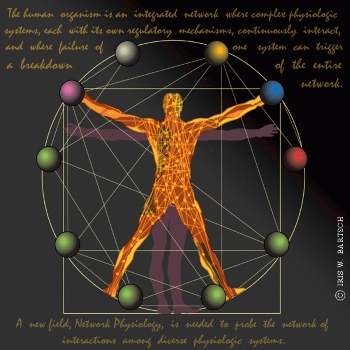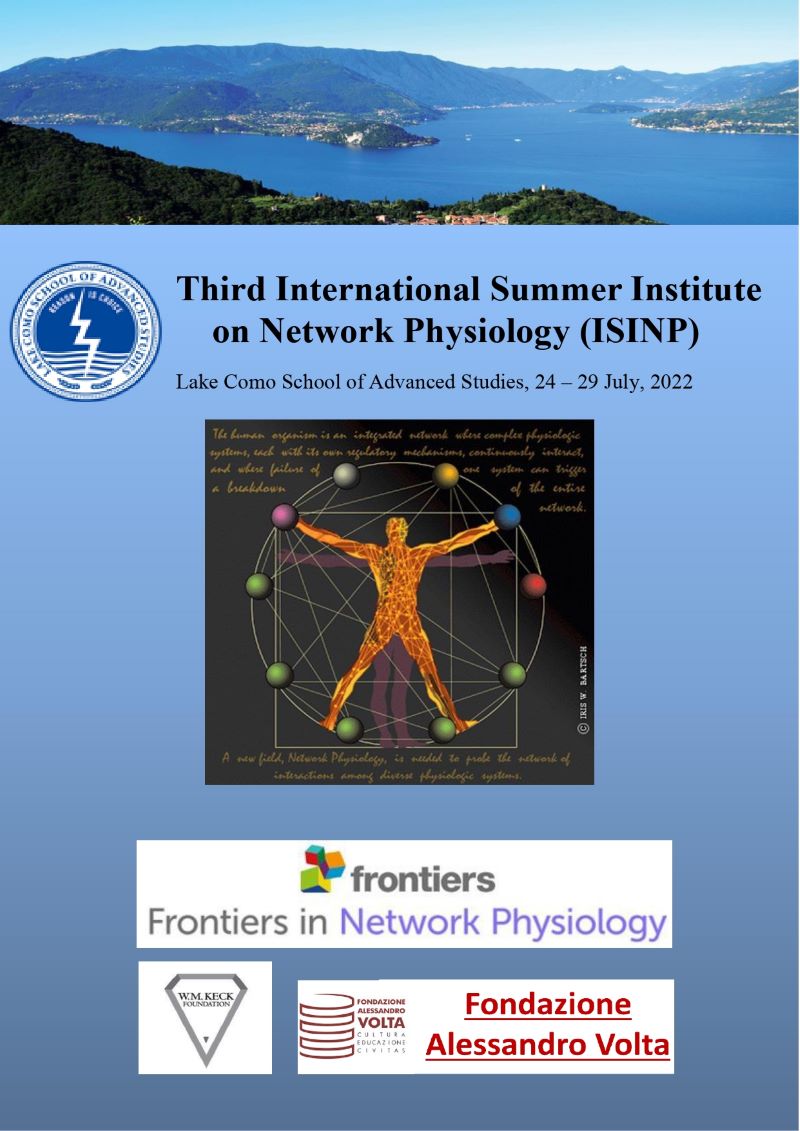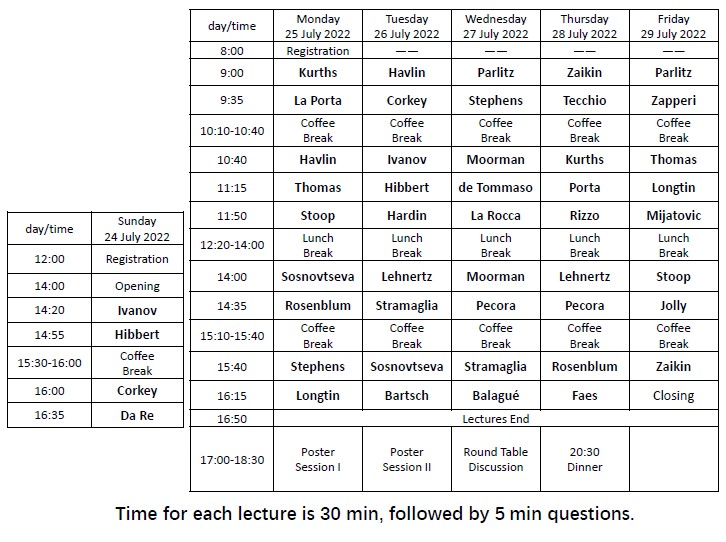Program

ISINP-2022 is supported by:


SCIENTIFIC PROGRAM
(download here ISINP-2022-Program.pdf)

ISINP-2022 TIME TABLE
(download here ISINP-2022 Time Table)

Round Table Discussion:
Klaus Lehnertz, Barbara Corkey, Ulrich Parlitz, J. Randall Moorman, Olga Sosnovtseva, Robert J. Thomas, Marina de Tommaso, Juergen Kurths, Luca Faes, Kathryn Hibbert, Christopher Stephens.

LECTURE TITLES
Natàlia Balague
INEFC, University of Barcelona, Barcelona, Spain
1. Percolation processes in network physiology of exercise: Understanding injuries and task disengagement [PDF]
Ronny P. Bartsch
Department of Physics, Bar-llan University, Israel
1. EEG synchronization networks of Parkinson’s disease patients with freezing of gait [PDF]
Barbara Corkey
Department of Medicine, Boston University, USA
1. The redox communication network as a regulator of metabolism [PDF]
2. The mitochondrial redox network as a regulator of body weight and obesity [PDF]
Caterina Da Re
Editorial Office, Frontiers, Switzerland
1. Frontiers: where scientists empower society
Marina de Tommaso
Neurology, Department of Psychiatric and Neurologic Sciences, Bari University, Italy
1. The cortical networks revised: motor nociceptive network and neuro limbic occipital networks in chronic pain and migraine, a fNIRS and EEG study [PDF]
Luca Faes
Department of Engineering, University of Palermo, Italy
1. Information-theoretic analysis of high-order interactions in physiological networks of oscillatory processes. [PDF]
Charles C. Hardin
Department of Pulmonary and Critical Care Medicine, Massachusetts General Hospital, USA Harvard Medical School, USA
1. Physiologic modeling of respiratory, immune and coagulation dynamics in critical COVID-19 [PDF]
Shlomo Havlin
Department of Physics, Bar-llan University, Israel
1. Network applications in physiology and biology [PDF]
2. Network science and applications [PDF]
Kathryn A. Hibbert
Department of Pulmonary and Critical Care Medicine, Massachusetts General Hospital, USA Harvard Medical School, USA
1. Heterogeneity in critical illness: challenges and opportunities [PDF]
2. COVID-19: A case for Network Physiology [PDF]
Plamen Ch. Ivanov
Keck Laboratory for Network Physiology, Department of Physics, Boston University, USA
Brigham and Women’s Hospital, Division of Sleep Medicine, Harvard Medical School, Boston, USA
1. The new field of Network Physiology: mapping the Human Physiolome [PDF]
2. Physiologic network interactions: novel hallmark of physiological state and function [PDF]
Mohit Kumar Jolly
Centre for BioSystems Science and Engineering, Indian Institute of Science, Bangalore, India
1. Network dynamics driving cancer metastasis: from design principles to therapeutic approaches [PDF]
Jürgen Kurths
Department of Physics, Humboldt University Berlin, Germany
Potsdam Institute for Climate Impact Research, Germany
1. Synchronization and chimera phenomena in neural networks with time delay and noise [PDF]
2. Quantifying stability in deterministic and stochastic complex networks and its application [PDF]
Klaus Lehnertz
Department of Epileptology at Bonn University Medical Center, Germany
1. Biological rhythms and evolving functional brain networks [PDF]
2. Controlling brain networks: Insights from epilepsy [PDF]
Andre Longtin
Physics Department, University of Ottawa, ON Canada
1. Complexity in Multi-Delay Physiological Feedback Systems [PDF]
2. Deterministic and Stochastic Brain Rhythms [PDF]
Gorana Mijatovic
Department of Power, Electronic and Communication Engineering, University of Novi Sad, Serbia
1. A new information-theoretic framework to analyze neural spike trains and physiological point processes [PDF]
Randall Moorman
Department of Medicine, Physiology, Biomedical Engineering, University of Virginia, USA
1. Challenges: applying network physiology to clinical medicine
2. Applied network physiology: new hammers, new nails [PDF, talk 1 and 2]
Ulrich Parlitz
Max Planck Research Group Biomedical Physics,
Max Planck Institute for Dynamics and Self-Organization, German
1. The nonlinear dynamics of the heart: collective excitation in networks of cardiac cell [PDF]
2. Modelling and controlling complex dynamics in cardiac networks [PDF]
Louis M. Pecora
U.S. Naval Research Laboratory, USA
1. Statistics of attractor embeddings in Reservoir Computing
2. Choosing optimal Reservoir Computers [PDF, talk 1 and 2]
Caterina A. M. La Porta
Center for Complexity and Biosystems, University of Milan, Italy
Department of Environmental Science and Policy, University of Milan, Italy
1. Classification of triple-negative breast cancers through a Boolean network model of the epithelial-mesenchymal transition [PDF]
Alberto Porta
Department of Biomedical Sciences for Health, University of Milan, Milan, Italy
Department of Cardiothoracic, Vascular Anesthesia and Intensive Care, IRCCS Policlinico San Donato, San Donato Milanese, Milan, Italy
1. A network physiology approach to cardiovascular, cardiorespiratory and cerebrovascular dynamic interactions [PDF]
Rossella Rizzo
Department of Engineering, University of Palermo, Italy
Keck Laboratory for Network Physiology, Department of Physics, Boston University, USA
1. Network physiology of cortico-muscular interactions: reorganization with sleep-stages transitions and neurodegenerative disorders [PDF]
Marianna La Rocca
Physics Department, Bari Aldo Moro University, Bari, Italy
Laboratory of Neuro Imaging, Stevens Neuroimaging and Informatics Institute,
Keck School of Medicine, University of Southern California, Los Angeles, CA, USA
1. Network physiology to study neurological diseases and chronic pain investigating different brain scales and data [PDF]
Michael G. Rosenblum
Department of Physics and Astronomy, University of Potsdam, Germany
1. Controlling collective synchrony by pulsatile stimulation [PDF]
2. Inferring phase and amplitude response of oscillatory systems from observations [PDF]
Olga Sosnovtseva
Department of Biomedical Sciences, University of Copenhagen, Denmark
1. Kidney function: Optimization of nephrovascular network [PDF]
2. Network Physiology aspects of diabetic kidney disease [PDF]
Christopher R. Stephens
Centro de Ciencias de la Complejidad, Instituto de Ciencias Nucleares,
Universidad Nacional Autónoma de México
1. From the Physiolome to the Conductome and back: A Conceptual Framework [PDF]
2. Applications to Obesity and Metabolic Disease of the Physiolome and Conductome [PDF]
Ruedi Stoop
Department of Physics & Neuroinformatics, ETH Zurich, Switzerland
1. Network physiology, criticality and computation – facts and fiction
2. What compiler-type computations are performed by biological neural networks?
Sebastiano Stramaglia
Dipartimento Interateneo di Fisica, Università degli Studi di Bari Aldo Moro, Italy
1. Modelling high-order behaviors in Network Physiology with Information Theory [PDF]
2. Localizing high order effects in time and across a complex system [PDF]
Franca Tecchio
Laboratory of Electrophysiology for Translational Neuroscience,
National Research Council, Italy
1. Cortico-muscular synchronization dependence on age, body side and visual feedback [PDF]
Robert J. Thomas
Harvard Medical School; Division of Pulmonary, Critical Care & Sleep,
Beth Israel Deaconess Medical Center, USA
1. Sleep as a network in health and disease [PDF]
2. Sleep transition networks – onset, offset, arousals and awakenings [PDF]
Alexey Zaikin
Computational and System Medicine, Department of Mathematics and Institute for Women’s Health, University College London, UK
1. Longitudinal, deep, and network biomarkers: Parenclitic and synolitic network analysis [PDF]
2. Intelligence and consciousness in genetic-neuron astrocyte networks [PDF]
Stefano Zapperi
Center for Complexity and Biosystems, University of Milan, Italy
Department of Physics, University of Milan, Italy
1. Information optimized multilayer network representation of high density electroencephalogram recordings [PDF]
